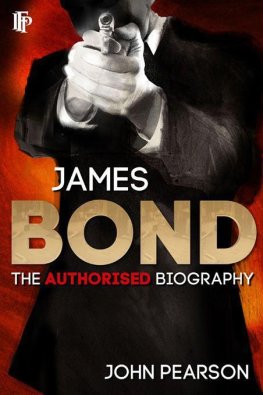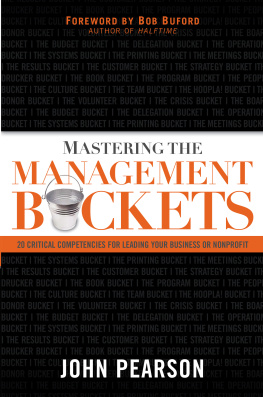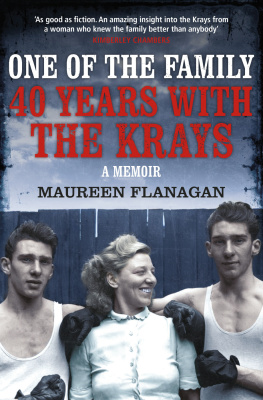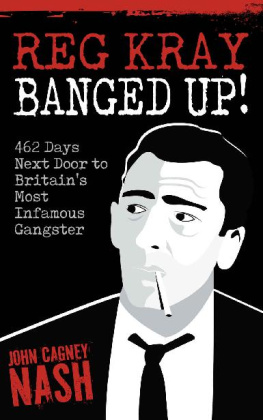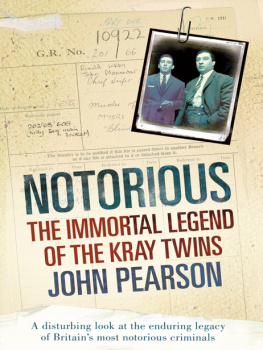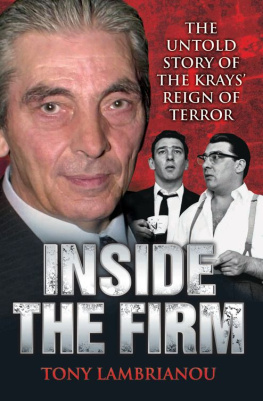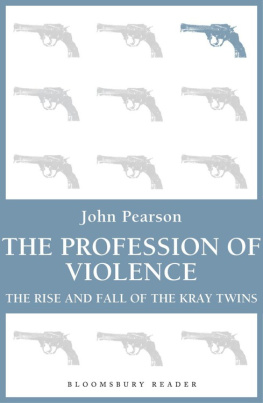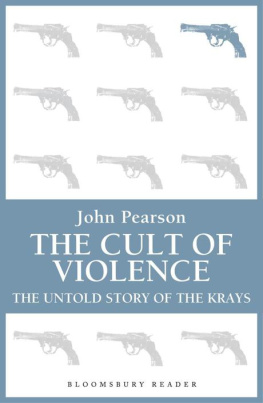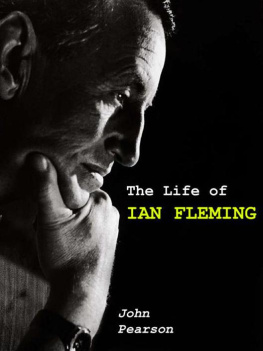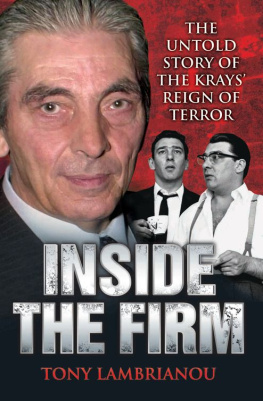John Pearson
The Cult of Violence
The Untold Story of the Krays

For copyright reasons, any images not belonging to the original author have been
removed from this book. The text has not been changed, and may still contain
references to missing images.
This electronic edition published in 2013 by Bloomsbury Reader
Bloomsbury Reader is a division of Bloomsbury Publishing Plc, 50 Bedford Square,
London WC1B 3DP
First published in Great Britain 2001 by Orion Books Ltd.
Copyright 2001 John Pearson
All rights reserved
You may not copy, distribute, transmit, reproduce or otherwise
make available this publication (or any part of it) in any form, or by any means
(including without limitation electronic, digital, optical, mechanical, photocopying,
printing, recording or otherwise), without the prior written permission of the
publisher. Any person who does any unauthorised act in relation to this publication
may be liable to criminal prosecution and civil claims for damages.
The moral right of the author is asserted.
eISBN: 9781448211524
Visit www.bloomsburyreader.com to find out more about our authors and their books
You will find extracts, author interviews, author events and you can sign up for
newsletters to be the first to hear about our latest releases and special offers.
For Lynette, of course
Contents
It is almost thirty-three years now since I first became involved with the Krays and, without knowing very much about them, rather casually agreed to become their official biographer. The result, The Profession of Violence, became an international best-seller, and much to my surprise, only the other day, I was informed that, after the Bible, it is the most popular book in HM prisons.
The Cult of Violence is a different book, and tells a very different story. When I met the Krays, I was still a relatively young former newspaper reporter and The Profession of Violence was essentially a reporters book, dealing with my immediate impressions, as I did my best to unravel what I now realise was an extremely complex story. When I wrote it I was also hampered by the fact that I possessed a vast amount of material I could not use not just material about the Twins themselves, but also lengthy interviews with many who confided in me on the strict understanding that I did not mention them while either of the Twins was still alive. More important still, when I wrote The Profession of Violence, what I now believe to be the most important chapters in the Kray Twins story had barely started. I ended The Profession of Violence with the sentence, Society was lucky; the Twins destroyed themselves. But as the Twins would abundantly prove over the next thirty years, I could not have been more wrong. While they spent the remainder of their lives in captivity repaying their debt to society, the Twins also established their reputation as the most celebrated criminals of our time, and created a myth which will probably outlast us all.
This is the story which The Cult of Violence seeks to tell. At the same time I have tried to give an explanation of what I think it was that made the Twins unique, and what lay behind the so-called Kray legend. Above all, now that the Twins and all the Kray family are dead, I feel free at last to tell the story of my personal involvement with the Krays and what I genuinely believe to be the truth about them.
One
Death of a Celebrity
Andrea (loudly): Unhappy the land that has no heroes.
Galileo: No. Unhappy the land that is in need of heroes.
Bertolt Brecht, Galileo
Finally, death kills even murderers. Reg Krays death, however, was unlike that of any other killer. Although Id known him for more than thirty years, as soon as I entered the hospital room where he was dying, I got the uneasy feeling I always had with him that I was in the presence of a celebrity. There he was, gaunt and shrunken, an old murderer with a tube draining toxins from his stomach through his nose, but even on his deathbed, living off a saline drip, fame refused to let him be.
Reg Kray was the most famous criminal in England. And of course he knew it.
In the road outside the hospital, a bored television crew was on deathwatch, waiting for any news about him, as they had been ever since his second major cancer operation the week before. Press cameramen were still making nuisances of themselves, hoping to snatch a picture of his wife Roberta, or of any of the celebrated criminals rumoured to be visiting him later in the day. Since Reg arrived at the hospital on 12 August 2000, thered been so many enquiries from well-wishers that the switchboard had set up a special line with daily bulletins on his state of health. Most of the callers left personal get-well messages too.
I was shocked at how frail and small he had become since I saw him only ten days earlier. But, as usual, he had all his wits about him and, unlike Jack the Hat McVitie, the fellow gangster he had murdered thirty-four years before, Reg Kray was being given time to die.
Anything you want? I asked him.
His smile hadnt changed; it was the same wry, faintly bitter, twisted little grin.
Id like a gin and tonic.
He meant this as a joke. Gin had always been his favourite tipple in the old days, but we both knew he couldnt swallow. I also knew that all that really mattered to him now was how he was going to be remembered. As I expected, he was desperately concerned about his funeral. He was still driven by his lifelong passion for celebrity, even as he lay dying.
This thirst for fame was always crucial to his being. It helped him face his constant fear of death, and blocked off any feelings of regret, still less remorse, for anything hed done.
Id do it all again, he muttered when I asked him.
Why not? Unlike most of us, he would always be remembered. If anyone remembered poor old Jack the Hat McVitie, it would be because the Krays had murdered him. Reg was the legend, Jack the legends sacrificial victim. Jack was the price that fame demanded.
Of course the Twins had also had a price to pay in Regs case the thirty-two years and four months he had been locked up, with the best years of his life being amputated, year by year, as time dragged by. But throughout those years, most of them spent as a Category A prisoner in maximum security, his passion for celebrity had been at work, and popular fascination grew steadily around him and his identical twin brother, Ron. There were books on them, films, endless articles. Every taxi driver in London knew someone who had known the Krays. By the time Ron died of a heart attack in Broadmoor in 1995, the Twins had become celebrities at the centre of a powerfully promoted cult of violent crime which has influenced the way we think of criminals. Say the two words violent criminal to virtually anyone today, and the response is automatic Krays.
As the embodiment of so-called gangster chic, the Kray Twins had attracted a wide following of young admirers, would-be gangsters and armchair psychopaths. As such they also helped to set the pattern for the current growth of British gangster movies. At the same time they became as firmly part of the dark mythology of British Crime as Dick Turpin, Bill Sykes and Jack the Ripper, while a nostalgic vision of the old East End (where they came from) with its old-style cockney villains gradually grew up around them.
This made them virtually unique as living criminal celebrities. Even America has no comparable example, with the possible exception of the flamboyant Mafia don John Gotti (currently serving three life sentences for murder and extortion).
Next page

